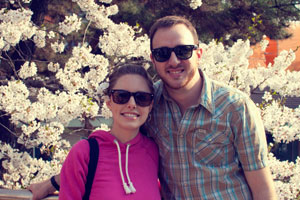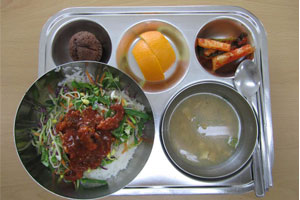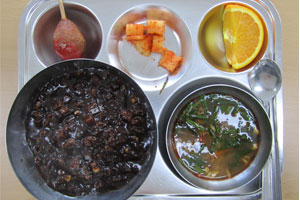“Sometimes love and appreciation for a different cultural food comes immediately. In Korea, the diet was a love I had to take a lot of chances on. It had to woo me, and I allowed it. Over time it has become a culinary experience that I will always cherish.”
These are the words of blogger, photographer and world traveler Andrew Phelps, who’s most recent resume addition includes English teacher in Korea.
During his more than two-year stint overseas, Phelps said one of the things that intrigued him most about Korea was the food. Born and raised on an American diet, the blogger says he was thrown into culture shock from the change in food the moment he and his wife arrived in South Korea.
“…Before I left U.S. soil to teach in the far east, I just assumed that all Asian food was similar to Panda Express. I couldn’t have been more wrong,” he said. “Korean food is incredibly unique to the Asian continent.”
During their travels, Phelps and his wife decided to make some changes to their lifestyles in an effort to get healthier. One of the biggest shifts they made was in their diet. The pair ate traditional Korean school lunches for their entire stay in the country, and Phelps decided to document one full month of the lunches to show family and friends back home how different the cuisine was. In addition to dietary changes, the couple also started exercising five to six days a week and lost a fair amount of weight in the process.
“With the growing obesity epidemic in the U.S. among youth, I thought it would be interesting to share what Korean students (and teachers) eat regularly to highlight the drastic differences,” said Phelps. On his blog, Till We Have Faces, he shared three posts in total, each sharing a glimpse of what Korean school lunches look like. And at the end of the project, he shared conclusions he’d drawn from the experience.
In a recent interview with Diets in Review, Phelps shared some of those thoughts.
Q: Tell us the concept behind the blog.
We moved to Korea in January of 2024 to be English teachers. We knew being away from our friends and families was going to be difficult so I started blogging to document our experiences here in Korea. As time has gone on, the blog has begun to take on a more photo blog-like experience.
Q: What compelled you to document your diet while in Korea?
One of the first things I noticed when we arrived in Korea almost two and a half years ago was how different the diet was. It was actually one of the most difficult things to adjust to due to all the unfamiliar foods and ways of preparing meals. We told friends and family back in the U.S. how different the food was, but I don’t think they really understood. So I decided to show them through images; thus the documentation. Pictures give a visual representation of the food, but still fall far short of the smell, texture and taste experience.
Q: How does Korean food differ from American food?

Clockwise from top left: Chocolate muffin; oranges; radish kimchi; tofu soup; and bibimbap with salty red sauce and octopus tentacles
Korean food differs from American food in significant ways. Their diet is anti-preservative, lacking in dairy and bread, and heavy on spicy peppers.
Korean food is obsessively anti-preservative. In Korean homes and restaurants they avoid boxed, canned, frozen, and packaged food like the plague. It’s possible to get these foods in the local supermarket, however, a traditional Korean meal will largely consist of fresh food.
The traditional Korean diet is also largely void of dairy products. Korea is a small mountainous land mass; therefore grazing fields for animals that produce milk are few and far between. Throughout their history, Koreans have learned to cook and eat without milk, butter or cheese. Even with the Western influence on Korea, dairy is rarely involved in Korean meals. This is partly due to the fact that many Koreans are lactose intolerant.
Rice is king in Korea. In America wheat is in charge, so we eat many types of food involving bread. Our first few months in Korea, we longed for a simple deli meat sandwich from Subway, or at least a restaurant that served sub sandwiches. But in Cheonan where we lived, they simply did not exist.
While Koreans have started to eat more bread, they still prefer to eat rice cake called tteok (pronounced “dock”). Tteok is made from glutinous rice flower and is extremely chewy. The word cake can be fooling though. By itself, tteok has very little taste at all. It’s similar to chewing on rubber. However, many types of rice cake exist: some are sweet and filled with sugary filling while other kinds are prepared with very spicy sauces such as the popular tteokbokki.

Clockwise from top left: Mini corn-dog; radish kimchi; oranges; squid and vegetable soup; and Jajangmyeon - a salty black sauce with meat and vegetables
The final key difference between American and Western food is spice. Koreans love to cook with hot peppers and many of their foods are covered in red pepper paste. In fact, many Koreans find American food to be very bland due to our lack of use of peppers. Their staple food, kimchi, is present at every meal. It’s made from fermented vegetables and other ingredients such as garlic, fish sauce, and more often than not, pepper paste.
Q: Do you feel like Koreans eat healthier than Americans?
Generally speaking, Koreans do eat much healthier than Americans. There are always exceptions to the rule, but I’ve been completely amazed at how much healthy and fresh food my students eat and enjoy. Some Koreans do give into the Western junk food, but even this is moderated by much smaller portion sizes.
Q: What are some of the most interesting things you’ve eaten since being there?
Koreans love seafood, which is easy to understand considering they are bordered by water on three sides. But seafood in Korea includes far more than traditional American seafood. It’s common for school lunches to have squid and octopus tentacles thrown into soups or other medleys with vegetables. But the most interesting thing I’ve eaten is a whole baby octopus. While visiting the port city of Busan last summer, we went to a seafood buffet where I came across a large bowl full of these tiny little creatures. I was feeling adventurous so I put it down in one bite like all the Koreans around me were doing.
Q: Do you personally feel healthier eating Korean food?
Typically after eating a Korean meal served at school or a Korean restaurant, I feel satisfied, but rarely “stuffed.” I don’t find myself groggy and sleepy after meals, and for the most part I do feel much healthier. The difference is physical as well. I’ve thinned out since living in Korea and I can sustain longer workouts.
Q: Any other thoughts you’d like to share?
If you’ve only ever had Chinese or Thai food, you’re still missing what Asian cuisine has to offer in Korean food. I highly recommend finding Korean restaurants or recipes and begin exploring all the awesomeness that is Korean food!
Also Read:
16 Simple Ways to Upgrade Your Health Today
Black Rice is New Antioxidant Star
all photos by Andrew Phelps
